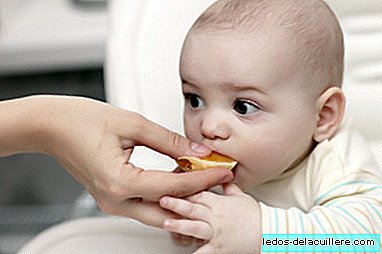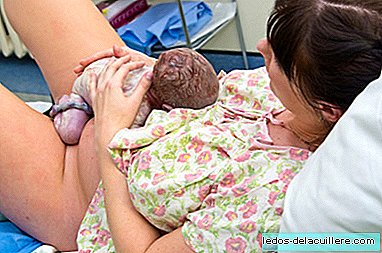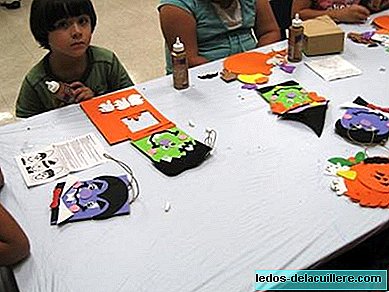
From 6 months of age occurs one of the main changes in baby feeding. That is when you should start offering your child another type of food, in addition to milk. It is what is known as the Start of complementary feeding, whose name means precisely that, which is a diet that complements breastfeeding, whether maternal or artificial.
Until 6 months of age, children should feed exclusively on milk. This diet, which both the World Health Organization (WHO) and the Spanish Association of Pediatrics recommend that it be with breast milk for being the most natural and beneficial for mother and baby, will be on demand, that is, whenever the baby requires it and for as long as necessary.
Is my baby ready to eat other foods?
As in other facets of child development, Not all babies are prepared for the start of complementary feeding at the same time. That's why you should offer new foods without forcing the baby or forcing it. Some signals Indicating that the baby is already prepared to start complementary feeding are:
- He endures sitting without help
- He has lost the extrusion reflex, that is, he does not spit or push food with his tongue when they touch his mouth
- He is interested in those foods he sees around him
These signs usually occur around 6 months of life, so at this stage it is recommended to start complementary feeding. At that time, you can start offering the baby another type of food, such as fruit or cereal, incorporating cereals with gluten little by little. Don't forget that milk will remain the baby's main food so, offer your breast often, if you continue breastfeeding, or formula, if you have chosen artificial breastfeeding.
How to introduce food?

The new foods that you incorporate into the baby's diet you must offer them one by one, waiting at least 3 days before introducing a new one, to observe possible reactions, intolerances or allergies. Cook food in the healthiest way possible (steamed, boiled or grilled) and give them either crushed (in the form of creams or purees) or small pieces or chamfered with a fork, depending on the capacity of each child. Avoid using salt and add a dash of olive oil.
Although there is no total consensus on the order and time at which to start offering certain foods, most professionals recommend start with cereals, fruits and vegetables at 6 months of age (except for those with green leaves, such as spinach and chard, which are delayed up to 12 months); white meat (chicken, lamb, turkey, rabbit ...) around 7 months; incorporate the veal at 8 months and start with the white fish (hake, sole, monkfish, etc.) over 9 months. Egg, legumes and cow's milk are recommended to be introduced after 12 months; red fruits and nuts (always crushed, as they can cause drowning) at 18 months; and shellfish and other crustaceans at 2 years of age.
The environment, fundamental to arouse interest in food
It is possible that on occasion the baby refuses to eat and refuses the food you offer. In these cases, you should consider some key factors for the child to show interest in food. Do not force the baby to eat, since in addition to counterproductive (it may be that he does not eat because he is ill or has discomfort) you will only get the opposite effect, and the meals can become a real odyssey.
Avoid using television and other electronic devices to entertain the child while eating. The goal is to be interested in new foods, not to eat without more, so it is better that there are no distractions.
A good way to be curious about food is to let it investigate, touch, manipulate and test them for yourself. It doesn't matter if your hands get dirty or stain the floor, that has an easy solution. In addition, some experts conclude that playing with food stimulates the cognitive development of babies.
Comfort and safety

The little one must be comfortable and at a suitable height. It is convenient to use an appropriate highchair for your age from the start of the complementary feeding. The Polly Progres5, from Chicco, is a evolutionary highchair with five different configurations to adapt to the baby's growth.
It is a only highchair approved to be used as a practical hammock from 0 months; like a conventional high chair, from the time the baby can sit by himself (around 6 months); and as a booster seat Until 36 months. To do this, it has a zipper system that will allow you to adapt it to each stage.
You can see its features and assembly in this video.
Having dinner with my family

At lunchtime it is important that the whole family get involved and participate in this routine and feels together at the table. Eating is a social act, a moment we usually enjoy with friends or other family members. Children often act by imitation, so they should see us have a fun and enjoyable time in front of the food, to be associated with something positive. The moments at the table will be relaxed and tense free, because if we are nervous when we feed the baby, we are also transmitting our mood and the situation can get worse.
Following these tips, the start of complementary feeding, an important milestone for the growth and development of your baby, it will be easier. Over time, around 12 months or so, your baby can already eat as one more member of the family, always trying to make them healthy and balanced dishes.
In Chicco Moments
Sport and motherhood: we tell you how to continue taking care of yourself
What signs indicate that the time has come to change bottles
How to give your baby a happy and relaxing bath
Photos | iStock.com/ Radist / KuznetsovDmitry / monkeybusinessimages












